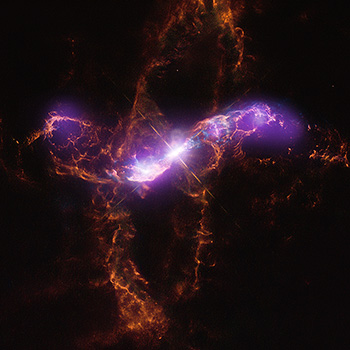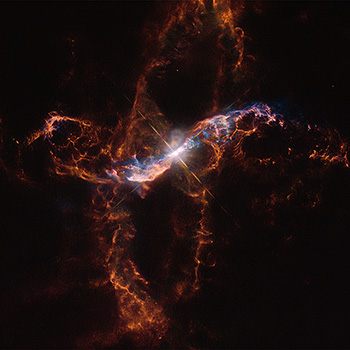
R Aquarii Sonification
R Aquarii is a system with two stars — a white dwarf and a red giant — in orbit around each other. In the sonification of R Aquarii, the volume changes in proportion to the brightness of sources in Hubble’s visible light and Chandra’s X-ray image, while the distance from the center dictates the musical pitch, meaning the higher notes are farther out. We can hear jets from the white dwarf as the cursor travels near the two o’clock and eight o’clock positions. The ribbon-like arcs captured by Hubble create a rising and falling melody that sounds similar to a set of singing bowls. These are metal bowls that produce different sounds and tones when struck with a mallet. Meanwhile the Chandra data are rendered to sound more like a synthetic and windy purr.
Access more information & file formats on this sonification
The Chandra sonifications were led by the Chandra X-ray Center (CXC), with input from NASA's Universe of Learning. The sustained collaboration was driven by visualization scientist Dr. Kimberly Arcand (CXC), astrophysicist Dr. Matt Russo and musician Andrew Santaguida (both of the SYSTEM Sounds project). For other sonifications, please see their linked pages.
cxcpub@cfa.harvard.edu
617-496-7941
60 Garden Street,
Cambridge, MA 02138 USA
Art Direction/Design: Kristin DiVona
Web Developers: Khajag Mgrdichian
& Kelly T.S. Williamson
Chandra X-ray Center, Operated for NASA by the Smithsonian Astrophysical Observatory. This site was developed with funding from NASA under contract NAS8-03060 | Privacy | Accessibility
Additional support from NASA's Universe of Learning (UoL). UoL materials are based upon work supported by NASA under award number NNX16AC65A to the Space
Telescope Science Institute, working in partnership with Caltech/IPAC, Jet Propulsion Laboratory, and Smithsonian Astrophysical Observatory.



